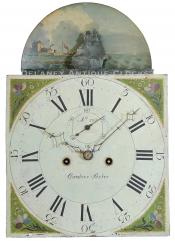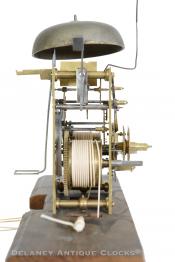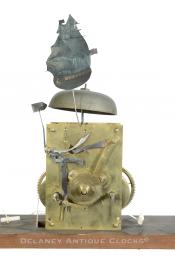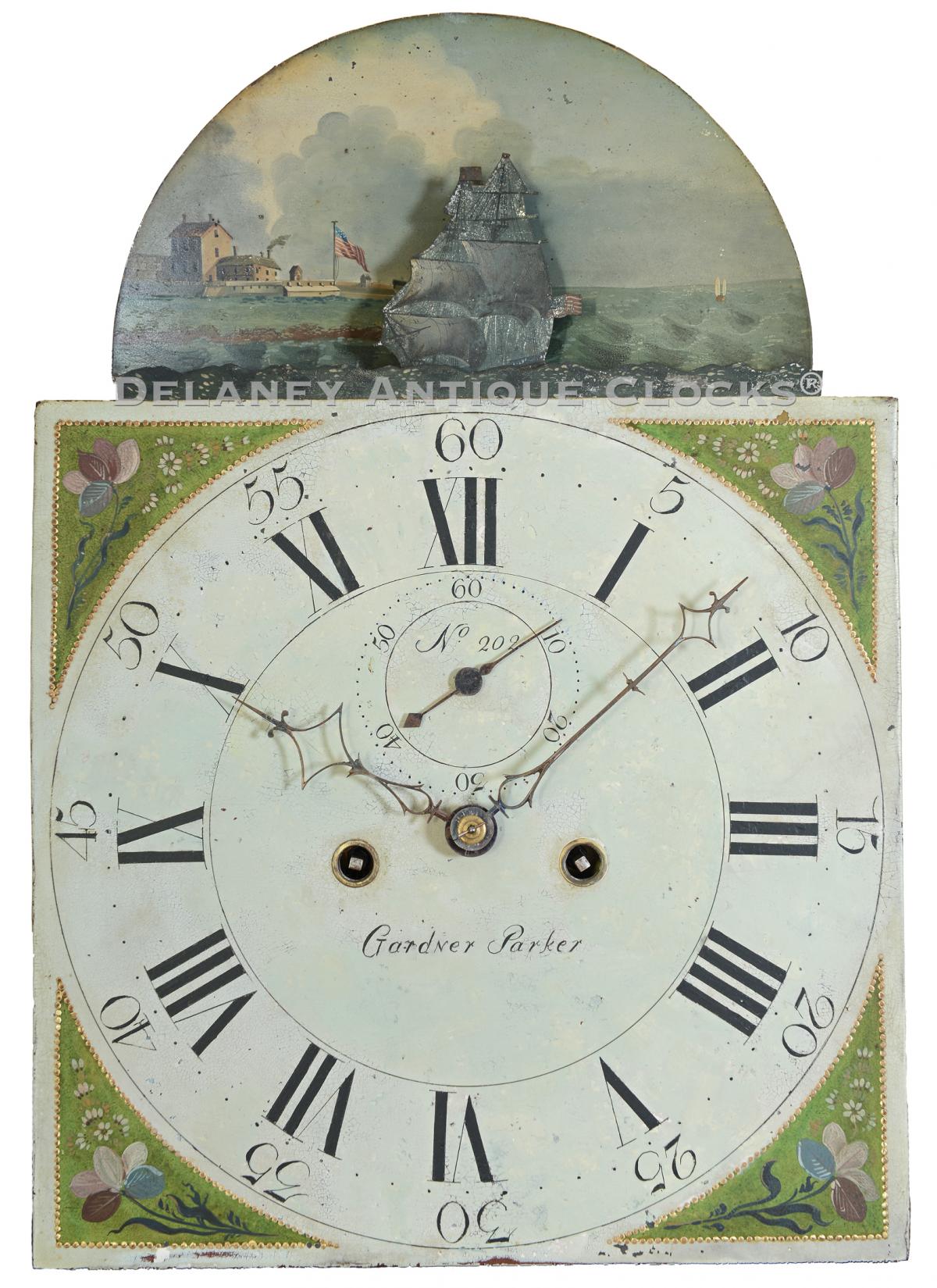Gardner Parker of Westborough, Massachusetts. An inlaid cherry-cased tall clock featuring a rocking-ship automated dial. CCC-46.
This Massachusetts tall clock was made by Gardner Parker of Westborough, Massachusetts (1772-1816).
The case is constructed in cherry and stands only 7 feet 3.5 inches tall to the top of the center finial. American-made tall clocks built to this scale can be difficult to locate. The case is elevated on an applied bracket base. The front corners of the base are fitted with fluted quarter columns. These terminate in brass quarter capitals. An applied half-round molding frames the outer edge of the rectangularly shaped and cross-banded waist door. This door is decorated with a line inlay pattern and opens to access the case’s interior. One will find the two drive weights and the brass-faced pendulum bob inside. The bonnet features traditional New England-style fretwork. Three-line inlaid finial plinths support the three ball-and-spike brass finials. Fully turned and fluted bonnet columns are mounted in brass capitals and positioned on either side of the hood door. The back corners of the bonnet are fitted with smoothly turned quarter columns. The sides of the hood are fitted with tombstone-shaped sidelights. The arched bonnet door is fitted with glass. The door opens to allow one access to the skillfully painted iron dial.
The Maker signs this painted iron dial, “Gardner Parker,” in script lettering. The location of the signature is positioned in the middle of the dial below the arbor for the hands. The four spandrel areas feature floral themes over a green field of color and are framed with a beaded pattern that is finished in gilt. The time track is formatted with Arabic-style five-minute markers. These are separated from the Roman-style hour numerals by a dotted minute ring. Steel hands display the appropriate time. A painted scene is located in the arch. This includes the automated feature of a rocking ship. The painted ship is depicted flying the American flag. The vessel moves or rocks gently from side to side with the pendulum’s motion. The painted scene behind the sailing ship includes a large residence built on a peninsula to the left. A large American flag is depicted mounted on a tall pole. This nautical theme is painted on a convex piece of metal, which adds to the visual depth of the scene.
This fine movement is constructed in brass and is of good quality. Four-turned pillars support the two brass plates. Hardened steel shafts support the polished steel pinions and brass gearing. The winding drums are grooved. The escapement is designed as a recoil format. The weight-driven movement is designed to run for eight days on a full wind. It is a two-train or a time-and-strike design, having a rack and snail striking system. As a result, it will strike each hour on the hour. This is done on a cast iron bell mounted above the movement.
This clock was made circa 1790 and stands approximately 7 feet 3.5 inches or 87.5 inches tall to the top of the center finial. This case is approximately 20.5 inches wide and 10.25 inches deep at the lower bonnet molding.
Inventory number CCC-46.
Gardner Parker was born in Hubbardston, Massachusetts on March 14th, 1772. He died in Westborough by his own hand on February 16th, 1816. He was the son of Isaac and Marjory Parker. They were originally from Shrewsbury and moved to Hubbardston and then to Westborough in 1777. Gardner married Assenath Sherman of Grafton. They had one child. A son name Perley Parker was born in Grafton and married Betsey Mellen. Gardner is said to have been trained in the art of clockmaking by the Willards. Paul Foley in his book, Willard’s Patent Time Pieces, speculates that he was trained by Benjamin the oldest of the Willard clockmaking brothers. He lists numerous entries where they had an on going business relationship manufacturing clock components. Most of these were charged to Benjamin. In October of 1800, Parker purchases some land in Westborough. He set up a mill at the location that is now called “Parker’s Folly.†It was named this because the dam he constructed in order to hold water back failed. This may have been an attempt to apply water power to clockmaking. Later he advertises the ability of make all types of clocks including tower clocks. One such tower clock was installed in Westborough in 1801, one was installed in Arlington in 1808 and one in Shrewsbury in before 1816. There are also records of his building church organs. Parkers reputation was a man of nervous temperament. He would go days without sleep in order to finish a project. In February of 1816, his mind could longer handle the strain. He shot himself in a fit of despondency.










